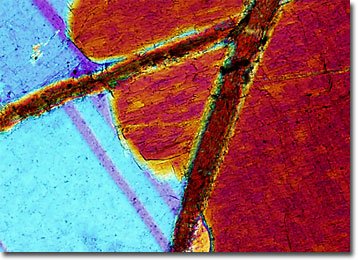Polarized Light Microscopy Digital Image Gallery
Amphibolite
Amphibolite is a type of rock chiefly comprised of minerals from the amphibole group. Slightly foliated, amphibolites generally form during the regional metamorphism of igneous rocks primarily composed of ferromagnesian minerals, though other types of the rocks are also known to occur.

View a second image of Amphibolite
The key components of amphibolites, amphiboles, are a group of extremely diverse, widely prevalent rock-forming silicate minerals. In fact, their collective name stems form the Greek word amphibolo, meaning “ambiguous,” which French mineralogist René-Just Haüy, who coined the term in 1801, found indicative of the tremendous amount of variety displayed by members of the group. Amphiboles may, for instance, appear as prismatic, needle-like, or fibrous crystals and can display a tremendous array of colors, ranging from white, green, and blue to dark brown and black. Due to such an extensive number of possible characteristics exhibited by members of this group of minerals, it is extremely difficult to identify them without the aid of a microscope or chemical analysis.
Amphibolites that are of metamorphic origin are common in a number of areas and are as various as the minerals for which they are named. They are, however, typically medium- or coarse-grained and often predominantly consist of hornblende and plagioclase feldspar. Hornblende is also typically the key mineral found in amphibolites that originate from igneous rocks. Indeed, the most widespread of these rock specimens are often referred to alternatively as hornblendite, a more restrictive moniker that indicates the specific amphibole they contain. Hornblendite and other types of amphibolite are sometimes utilized for industrial purposes, primarily as crushed stone or as a building material.
